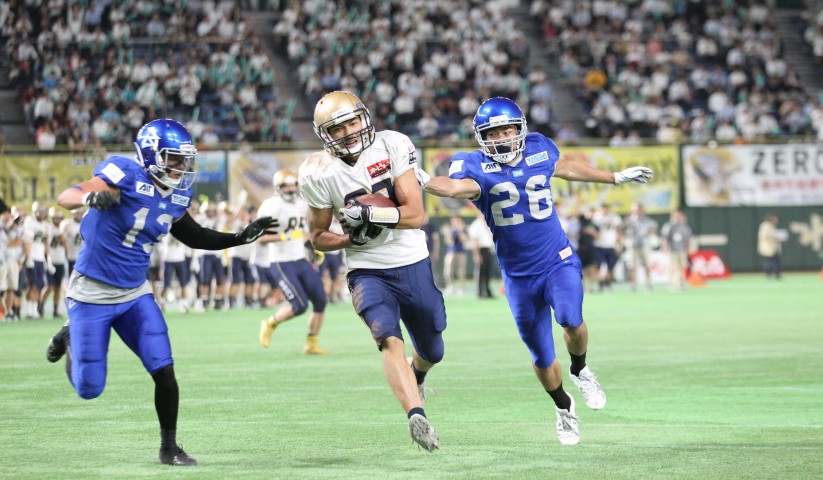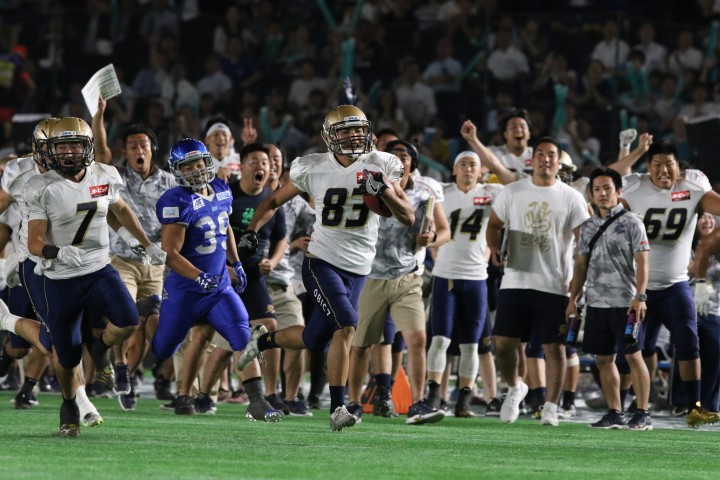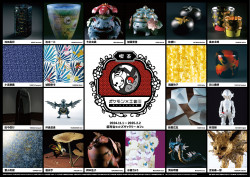
In the 1992 sports comedy Mr. Baseball, Tom Selleck plays a washed-up major leaguer who comes to Japan when no other team will have him. After learning to curb his ego the hard way with a crash course in Japanese baseball culture, his character wins both the big game and the girl by the end of the movie.
For foreign athletes today, however, it’s all about respect and teamwork from the outset. We spoke to people involved in a number of sports who are bringing their A-game to sports in Japan in a variety of ways.
While professional baseball and soccer are the undisputed kings of professional team sports in Japan, American football enjoys a relatively modest but very loyal fan base here. Shigeyuki Watanabe is a director for the X-League, Japan’s top-level American football league. Until recently he was involved with the Obic Seagulls, a first-division team based in Chiba.
The X-League, like many leagues in Japan that do not enjoy the national attention that top sports such as baseball or sumo do, is considered a “semi-pro” league, and the system for these types of leagues may be striking to Western fans accustomed to a clear line drawn between amateur and professional sports.

“There are two types of teams in the X-League,” explains Watanabe. “First there are company teams, in which every player is an employee of the sponsoring firm. Currently there are only two such teams in the X-League division, Fujitsu Frontiers and Panasonic Impulse. The rest are club teams and players aren’t necessarily working for the sponsor.”
Like their Japanese teammates, foreign players on X-League club teams have day jobs, which they need to get their visa. Each team can have up to four foreign players, who may come to Japan in a variety of ways. Watanabe says that they might come through outsourcing firms to work, for example, as English teachers. How much time they can devote to American football depends on their employer, but in this respect they are no different from their Japanese teammates, who are also juggling their work and football.
According to Watanabe, the X-League has seen a steady rise in the quality of overseas players coming to Japan over the last ten years, including players from NCAA Division 1 universities, and even players that have spent some time on NFL teams. “We’re now seeing players with NFL-level skills coming here to play. This is helping to take the game in Japan to a new level.”
Raising the level of play

Seaun Eddy has just completed his rookie year playing in the B.League, Japan’s professional men’s basketball league, and agrees that foreign players inject excitement into the game. “The overseas players definitely bring new energy and a different style of play, which is great to watch.” As in the X-League, each team is limited when it comes to foreign players on their roster – three in this case.
When it comes to working out which players to send out at any given time, coaches follow rules to ensure a balance between their Japanese and non-Japanese team members. “During the four quarters that make up a basketball game, a team can have two foreign players on the court at any time during two of the quarters, and one foreign player on during the other two quarters,” Eddy explains. “The coach decides how to distribute their foreign player slots among the quarters.”
Rugby has been gaining in popularity here since the 2015 World Cup, when Japan’s national team, the Brave Blossoms, scored upset wins against some of rugby’s traditional powerhouse teams. Japan’s rugby union league is known as the Top League, with teams owned by major companies and many players working for their sponsoring firm. Good salaries and opportunities for advancement have been attracting full-time professionals from overseas, particularly from Australia and New Zealand.
Kiwi Tamati Ellison plays for the Ricoh Black Rams, a Tokyo-based team in Japan’s rugby union Top League. He notes that the main difference between the Japanese and non-Japanese players is that the foreign players can train throughout the day, while Japanese players balance their training with their office jobs at the company. Ellison predicts good things ahead. “Rugby in Japan is growing, and the standard of play is beginning to align with the top-tier international sides. If this continues, Japan will be great at the 2019 World Cup.”
Futsal is a variant of soccer, played mainly on a hard court indoors. While many people in Japan know about the sport, they are still unaware of the existence of the F-League, Japan’s semi-pro futsal league, says Higor Maciel Pires, the goalkeeper for Pescadola Machida in Tokyo. Brazilian by birth, the pro athlete got his Japanese citizenship last year.
“In terms of differences between styles of playing, Japanese players are fast and agile, but foreign athletes tend to be physically stronger, so we use our skills a bit differently,” says Maciel. “Most foreign athletes in F-league are hired to play professionally, whereas most Japanese players are semi-pro or earn money through coaching at schools instead of getting paid to play. Teams in Brazil practice twice a day, but in Japan it’s usually just once a day. Some teams only practice three to four times a week, since they have other jobs outside of futsal.”
Maciel encourages those unfamiliar with his sport to come and watch a game. “Our ultimate goal is to make F-league a fully professional league in the future. Futsal is always associated with soccer, but it’s dynamic and much more fast-paced, and you get to see the action up close. The players also take time to greet all the supporters after the games, and we try to close the distance between professional athletes and [their] supporters.”

Domestic sports attracting foreign players
One professional sport in which Japan is already leading the world is wrestling. Australian Rionne Fujiwara, a professional wrestler who has lived here for 15 years, offers a glimpse into the unique world of wrestling in this country.
“There are three main styles in professional wrestling. American wrestling is a lot more entertainment-based, Mexican Lucha Libre is more acrobatic, and Japanese pro wrestling is all about the “fighting spirit” of the athlete and the technical ability. Because of this difference, we foreigners tend to have different ways of approaching the sport compared to Japanese wrestlers. There are no right or wrong ways, just different,” he says.
Fujiwara says that nationality doesn’t matter if you are living in Japan and training here. “You have to abide by the Japanese rules of the dojo and immerse yourself in how they do things. Dojo life is cleaning in the morning, training every day from 10am to 1pm, eating chanko nabe … The senior-junior system is the rule and the training is intense. There is punishment for the ones that cannot get through the training and this builds mental toughness, which is definitely a Japanese sports trait.”
Another foreign aficionado of combat sports is professional kickboxer Johnny Oliveira, who hails from Brazil. Currently ranked number four in Japan, he works as a personal trainer and fights for a Tokyo-based gym under the Shin Nihon Kickboxing Association. He says kickboxing offers many benefits. “It can assist people in developing mental toughness, quick decision making, conquering fears and developing better self-esteem.”
Oliveira has fought professionally in other countries and has found the system in Japan to be very well organized. “For example, fighters here have insurance and regular medical check-ups, which is not so common back home.”
Struggling to get a foothold in Japan
And finally, a sport where top players overseas earn idol-like status and lavish salaries but which leaves many Japanese scratching their heads — cricket. “A lot of people I randomly meet ask me what I do, and when I tell them, they usually say, ‘I didn’t know there was cricket in Japan’,” admits Dhugal Bedingfield, who works for the Japan Cricket Association. In his role as Community Cricket Manager, he oversees all the cricket leagues and tournaments in Japan, as well as working closely with the Japan national teams in the capacity of coach and tournament director.
One challenge of managing cricket in Japan for Bedingfield is finding grounds with big grassy areas to play on. “One ground that is occasionally used for junior cricket is located by the river in Edogawa, Tokyo. A path traverses the ground just behind where the wicket keeper stands. It is not uncommon for the game to be delayed while elderly ladies on bicycles slowly make their way across the field,” he says with a grin.
“Many of the Japanese players have taken up cricket at university and are competing against players from other countries who have had a cricket bat strapped to their hand from birth. However, the Japanese players often show a lot more athleticism and teamwork than the foreign players and they practice harder,” notes Bedingfield. There are currently only amateur cricketers in Japan, but with the introduction of junior programs, such as Cricket Blast, the sport is seeing a rise in young players, which he says bodes well for Japan’s national teams a few years down the line.







